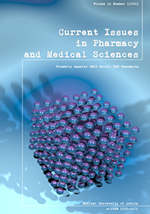Comparison of disc-diffusion and disc-volatilization assays for determining the antimicrobial activity of Thymus vulgaris L. essential oil
DOI:
https://doi.org/10.2478/cipms-2023-0027Keywords:
essential oil, biological activity, vapour phase, liquid phase, ThymeAbstract
Essential oils (EOs), being mixtures of various natural compounds, constitute an attractive source of novel antimicrobial agents. Along with multiple studies concerning their rich biological activity, there are different methods allowing to determine both antimicrobial activity in direct contact, as well as through the activity of vapours. Thyme constitutes one of the most common aromatic herbs used for pharmaceutical, cosmetic and culinary purposes. The aim of the study was to compare the antibacterial activity of liquid and vapour phases of Thymus vulgaris L. essential oil (TEO) against most common pathogenic Gram-positive (Staphylococcus aureus ATCC 25913, Enterococcus faecalis ATCC 29212, Bacillus cereus ATCC 10876) and Gram-negative (Escherichia coli ATCC 25922, Salmonella typhimurium ATCC 14028, Pseudomonas aeruginosa ATCC 27853) microorganisms. To determine TEO antibacterial properties, two methods were used: disc-diffusion assay so as to test activity in direct contact; disc-volatilization assay so as to determine activity in gaseous contact.
Statistical analysis showed that Gram-positive bacteria were more sensitive to TEO vapours than Gram-negative (p=0.005), while in the case of disc-diffusion assay, no such differences were evident. Moreover, sensitivity towards TEO differed among Gram-positive bacteria in disc-diffusion (p=0.009) and disc-volatilization assay (p=0.001). Among Gram-negative rods, a statistically higher sensitivity regarding E. coli was noted when compared to S. typhimurium in both direct (p=0.011) and gaseous (p=0.006) TEO contact. No activity of TEO against P. aeruginosa was found.
As thyme essential oil exhibited significant antimicrobial activity against Gram-positive bacteria in gaseous contact, this justifies its use as an addition to inhalation agents to prevent or support the treatment of upper respiratory tract infections. Further studies should therefore apply other methods for determining the antibacterial activity of TEO vapours to assess the exact minimal concentration inhibiting bacterial growth.
References
1. Reyes-Jurad, F, Franco-Vega A, Ramírez-Corona N, Palou E, López-Malo A. Essential oils: antimicrobial activities, extraction methods, and their modeling. Food Eng Rev. 2015;7:275297.
2. Dagli N, Dagli R. Possible use of essential oils in dentistry. J Int Oral Health. 2014;6:I–III.
3. Ali B, Al-Wabel N.A. Shams S, Ahamad A, Khan SA, Anwar F. Essential oils used in aromatherapy: A systemic review. Asian Pac J Trop Biomed. 2015;5:601611.
4. Marzec M, Polakowski C, Chilczuk R, Kolodziej B. Evaluation of essential oil content, its chemical composition and price of thyme (Thymus vulgaris L.) raw material available in Poland. Herba Pol. 2010;56:37–52.
5. Patil SM, Ramu R, Shirahatti PS, Shivamallu C, Amachawadi RG. A systematic review on ethnopharmacology, phytochemistry and pharmacological aspects of Thymus vulgaris Linn. Heliyon. 2021;7:e07054.
6. Antih J, Houdkova M, Urbanova K, Kokoska L. Antibacterial activity of Thymus vulgaris L. essential oil vapours and their GC/MS analysis using solid-phase microextraction and syringe headspace Sampling Techniques. Molecules. 2021;26:6553.
7. Borugă O, Jianu C, Mişcă C., Goleţ I, Gruia AT, Horhat FG. Thymus vulgaris essential oil: chemical composition and antimicrobial activity. J Med Life. 2014;7:56–60.
8. Fani M, Kohanteb J. In vitro antimicrobial activity of Thymus vulgaris essential oil against major oral pathogens. J Evid Based Complementary Altern Med. 2017;22:66066.
9. Silva AS, Tewari D, Sureda A, Suntar I, Belwal T, Battino M, et al. The evidence of health benefits and food applications of Thymus vulgaris L. Trends Food Sci Technol. 2021;117:218227.
10. Horváth G& Ács K. Essential oils in the treatment of respiratory tract diseases highlighting their role in bacterial infections and their anti‐inflammatory action: a review. Flavour Fragr J. 2015;30:331341.
11. Bezić N, Skočibušić M, Dunkić V, Radonić A. Composition and antimicrobial activity of Achillea clavennae L. essential oil. Phytother Res. 2003;17:1037040.
12. Liu T, Kang J, Liu L. Thymol as a critical component of Thymus vulgaris L. essential oil combats Pseudomonas aeruginosa by intercalating DNA and inactivating biofilm. LWT. 2021;136:110354.
13. Sienkiewicz M, Wasiela M. Aktywność olejków tymiankowego i lawendowego wobec opornych na antybiotyki szczepów klinicznych Pseudomonas aeruginos). Post Fitoter. 2012;3:139145.
14. Ultee A, Smid EJ. Influence of carvacrol on growth and toxin production by Bacillus cereus. Int J Food Microbiol. 2001;64:37378.
15. Ghahremani-Chabok A, Bagheri-Nesami M, Shorofi SA, Mousavinasab SN, Gholipour-Baradari A, Saeedi, M. The effects of Thymus vulgaris inhalation therapy on airway status and oxygen saturation of patients under mechanical ventilation: A randomized clinical trial. Adv Integr Med. 2021;8:92–100.
16. Cos P, Vlietinck AJ, Berghe DV, Maes L. Anti-infective potential of natural products: How to develop a stronger in vitro ‘proof-of-concept’. J Ethnopharmacol. 2006;106:290–302.
17. Rodrigues FF, Costa JG, Coutinho HD. Synergy effects of the antibiotics gentamicin and the essential oil of Croton zehntneri. Phytomedicine. 2009;16:105255.
18. Houdkova M, Chaure A, Doskocil I, Havlik J, Kokoska L. New broth macrodilution volatilization method for antibacterial susceptibility testing of volatile agents and evaluation of their toxicity using modified MTT assay in vitro. Molecules. 2021;26:4179.
19. Inouyea S, Takizawab T, Yamaguchia H. Antibacterial activity of essential oils and their major constituents against respiratory tract pathogens by gaseous contact. J Antimicrob Chemother. 2001;47:565–73.
20. Netopilova M, Houdkova M, Urbanova K, Rondevaldova J, Kokoska L. Validation of qualitative broth volatilization checkerboard method for testing of essential oils: Dual-column GC–FID/MS analysis and in vitro combinatory antimicrobial effect of Origanum vulgare and Thymus vulgaris against Staphylococcus aureus in liquid and vapor phases. Plants. 2021;10:393.
Downloads
Published
Issue
Section
License
Copyright (c) 2023 Authors

This work is licensed under a Creative Commons Attribution-NonCommercial-NoDerivatives 3.0 Unported License.


